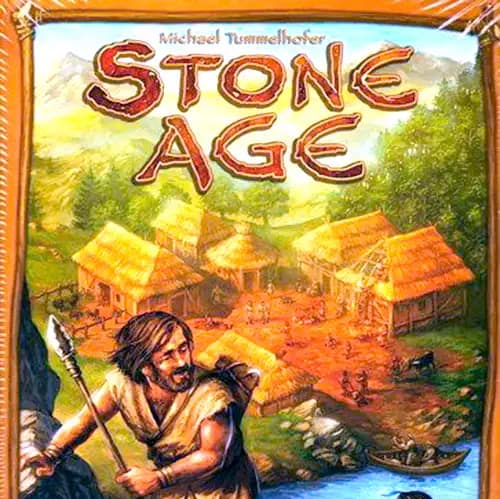STONE AGE
BOARDGAME
Theme: Resource Management / Strategy
2 – 4 Players
Playtime 60-90 Min.
Stone Age is a popular worker placement and resource management board game set in prehistoric times, designed by Michael Tummelhofer and published the first time in 2008. It received several editions. The game transports players into the lives of early human tribes, where they must gather resources, develop tools, and expand their tribes to thrive in the harsh environment of the Stone Age.
It is accessible yet with deep gameplay, beautiful components, and strong thematic integration. It’s a game of careful planning, worker management, and resource optimization.
Game Objective
In Stone Age, players take on the roles of tribe leaders who must manage their workers to collect resources, build structures, and advance their civilization. The goal is to accumulate the most points by the end of the game, which is achieved through various strategies, including gathering resources (wood, clay, stone, and gold), expanding their workforce, constructing buildings, and developing civilization cards.
Players must balance short-term survival (feeding their tribe) with long-term growth (building huts and acquiring culture). Every action costs resources and requires strategic thinking to optimize efficiency.
Game Setup
Each player starts with five workers, which are placed on various parts of the game board to gather resources, hunt for food, craft tools, build huts, and progress in civilization. Each round consists of several phases:
Worker Placement:
Players take turns placing their workers on different locations on the board to gather resources, increase their population, or advance their civilization.
Action Resolution:
After all workers are placed, players resolve the actions associated with each location.
Feeding the Tribe:
At the end of each round, players must feed their tribe by providing enough food for all their workers. Failing to feed them results in point penalties.
Game Board and Areas
The game board represents a prehistoric landscape and is divided into different locations where players can send their workers to perform various actions. These areas include:
Forest, Clay Pit, Quarry, and River:
Players place workers in these areas to gather resources like wood, clay, stone, and gold. The number of workers assigned to a resource determines how many dice are rolled to collect that resource. The result is divided by the resource value (e.g., wood is 3, clay is 4) to determine how much of it is collected.
Hunting Grounds:
Workers here collect food by rolling dice. The total result is divided by 2 to determine the amount of food gathered.
Tool Maker:
This location allows players to gain tools, which help modify dice rolls, making resource gathering more efficient.
Hut Building:
Here, players spend resources to construct buildings, which grant points.
Agriculture Field:
By placing a worker here, players can increase their food production, making it easier to feed their workers in future rounds.
Love Hut:
By sending two workers to this location, players can increase their tribe’s population, gaining an additional worker for future rounds.
Civilization Cards:
These cards provide end-game points and special abilities, such as resource bonuses or multipliers based on various factors like tool levels, agriculture, and building cards.
Strategy
Players must decide how to balance the need for immediate resources (food and materials for buildings) with long-term investments (agriculture, tool-making, and population growth). Choosing the right moment to expand your population is crucial, as more workers can gather more resources but also require more food each round. Civilization cards also play a key role in securing end-game points through multipliers for various aspects of the player’s civilization.
Endgame and Scoring
The game ends when one of two conditions is met:
• The civilization card stack is empty.
• There are not enough building tiles to fill the building spaces.
After either condition is triggered, the round is completed, and final scoring occurs. Points are calculated based on:
• Points from constructed buildings.
• Points from civilization cards, including multipliers for tools, agriculture, and buildings.
• Any leftover resources.
The player with the highest score is declared the winner.


